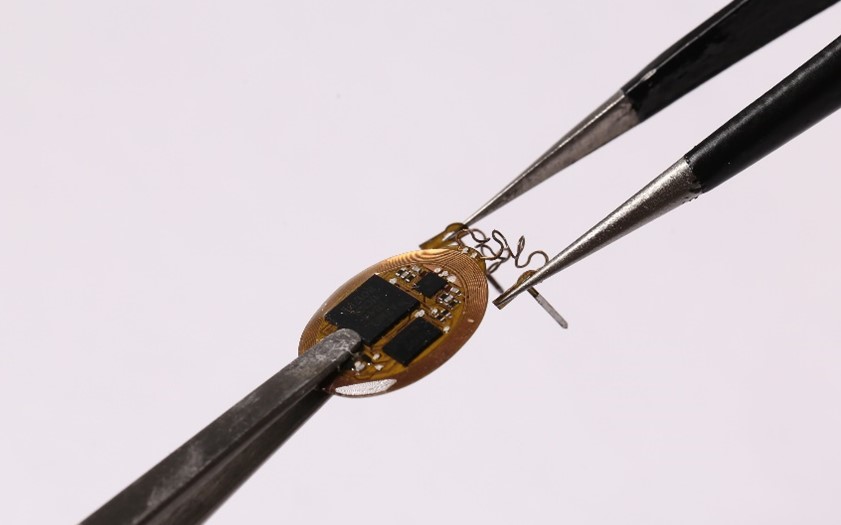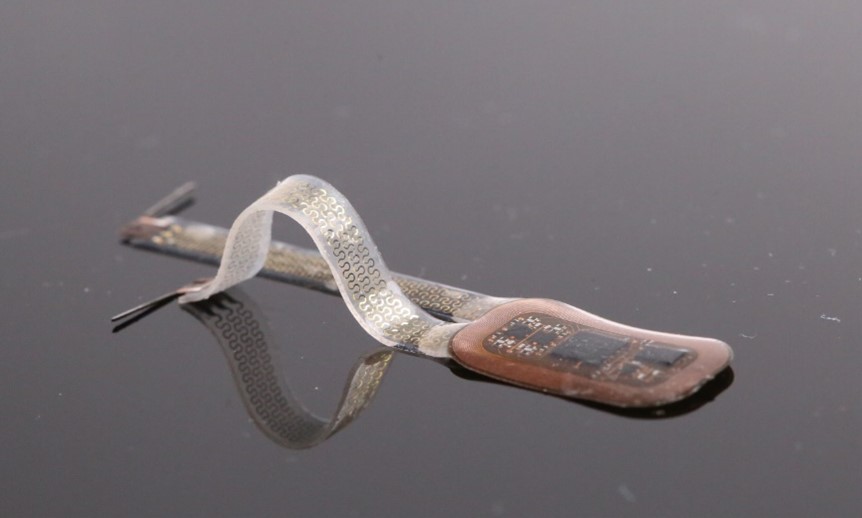Wireless Optogenetics --- A New Approach for Deciphering Neural Network
Published in Protocols & Methods
-- Exploration of the underlying principles of neural activities and their causal relationships with behavioral outcomes require a comprehensive experimental system capable of modulating activities of specific pathways in the nervous system in real-time without affecting the subjects’ natural behaviors. Our research addresses this requirement by developing wireless optogenetic devices for neural modulations, surgical protocols for subdermal implantations, and experimental implementation for studies of behavior in small animal models.
Optogenetics is a recently developed biological tool employed to modulate the activities of transgenic cells with millisecond precision via delivered photons at specific wavelengths. This method exploits the viral transgenic approach to express opsins (a certain type of light-controlled transmembrane ion channels) on target cell populations. Such genetic precision allows specific activation or inhibition of cells expressed with those opsins when receiving proper light dosage and wavelengths. Compared to electrical and pharmacological stimulation approaches, optogenetics has relatively higher spatiotemporal resolution and cell specificity on neuromodulation.
“How to use optogenetics in behavior studies?”
Efficient and precise light delivery to the target tissue is the basis for applying optogenetic method in behavior studies. Optical fibers that developed from telecommunication industry, which direct light from external connected sources, serve as the current major tools for light delivery for optogenetic behavior studies. In addition, recent advancements in the semiconductor industry enable manufacture of high quality and efficient microscale inorganic light emitting diodes (µ-ILEDs), which can reach about the sizes of individual neurons (~ 10 µm). These optoelectronic components can serve as localized light stimulators to control the activities of nervous systems at cellular level. However, both technologies rely on either tethered connections or heavy battery-operated over-head stages for guiding light waves or powering the µ-ILEDs. These configurations will significantly reduce animal’s mobility and induce natural barriers for their social interactions, posting constraints on the context of complex behavior studies.
Our strategy to address these constrains is to exploit wireless power transfer via resonant inductive coupling between paired transmission and receiver antenna at radio frequency (RF, 13.56 MHz) as sustainable power sources to remove all forms of tethers and bulky batteries. In operation, we have the transmission antenna circulates around the experimental enclosures with various architectures required by different behavior study settings, such as cages, mazes, tunnels, and etc. A power source drives the transmission antenna with an oscillating electrical current to generate magnetic field inside the experimental cavity. The implanted devices, which include a receiver antenna in the form of a planar coil around the perimeter of the device, harvest this magnetic energy to provide power to the battery-free implant. Penetrating probes equipped with one or several µ-ILEDs at the tips serve as the local stimulator for optogenetic stimulation of living cells. Furthermore, a conformal bilayer of parylene and silicone encapsulates the device and provides a compliant biocompatible device/tissue interface to reduce foreign body responses after implantation.
This sophisticated, yet miniaturized, electronic platform further supports programmable operation in real-time. The experimenter gains access to the device configuration using near field communication (NFC), similarly to those wireless pay station. On the device, a low power microcontroller that runs a specialized firmware, implements multi-channel operation of up to four independent µ-ILED with user programable stimulation parameters: frequency, duty cycle, intensity, and illumination modality. The interactive devices are controlled with software which facilitates the experimenter to adjust these stimulation parameters at will. In more advanced experimental implementations, such as closed-loop systems for behavioral modulation, this planform would allow autonomous optogenetics stimulation modulation based on behavioral inputs feed from peripheral cameras, interaction sensors, etc.

Photographic image of a head-mounted wireless battery-free optogenetic device [1]
In our recent Nature Protocols paper (link), we show in detail the procedure to make and implant these type of devices as well as the instructions and recommendations to set up practical experimental arenas.
On the other hand, exploiting the miniaturized characteristics of these devices, we develop a convenient surgical procedure for full subdermal implantation (link) which removes all forms of external tethers. The surgical procedure only requires a stereotaxic frame and standard surgical tools. In general, the surgery starts with a small incision on the overhead skin followed by injection of probes to the targeted brain regions. Our recent work published in Nature Neuroscience (link) shows that implantation of these subdermal devices will not affect animals’ naturalistic behaviors (mobility and locomotor activity).
“What are the unique opportunities enabled by this new technology?”
Our developed RF smart NFC wireless optogenetic platform removes all forms of tethered external connections and heavy overhead stages required by “traditional” optogenetic set ups. In addition, our subdermal implantable devices remove most physical disturbances on animals’ naturalistic activities and enable researchers to explore neural mechanisms underlying complex behaviors. One interesting possibility is reveal the ‘interbrain’ principles behind social interactions. Recently, Kingsbury et al reports increased interbrain synchrony in medial prefrontal cortex (mPFC) occurs when two mice are in social interactions. Enlightened by this finding, we used the newly developed advanced wireless optogenetic devices to causally change the level of interbrain synchrony in mPFC among the same paired mice. By doing so, we are able to enhance social interaction between paired mice by stimulating them at the same frequency. This study, enabled by a joint collaboration between material scientists and neuroscientists, was the first time to causally manipulate synchrony among subjects after two decades of research on brain-to-brain synchrony in animals and human. Detailed results are reported in our recent work published in Nature Neuroscience paper (link).
“What is the next expected breakthrough?”
So far, we are able to explore advanced neuroscience behavior paradigms by modulating neural activities independently among groups of animals. From our perspectives, future developments on wireless optogenetic platform should focus on integrating biosensors that reflect the bio-electrochemical processes elicited during or after optogenetic stimulations, to bridge the knowledge gap between neural activities and outcome behaviors. Realization of this purpose requires upgrades in electronic functions as well as improvements on energy harvesting capabilities. We report a promising two-part device design concept (link) and fabrication protocol (link) that can serve as the basis for future developments. The idea of two-part device is to physically separate the electronic module with the stimulation or sensing sites and electrically connect them with mechanically compliant interconnection traces that can chronically sustain through activity-induced body deformations. In practice, we use lithographically defined serpentine metal traces symmetrically embedded in parylene and silicone to accommodate repetitive compression, elongation and bending. Compared to previously reported wireless devices where their electronic modules should be implanted at or near the stimulation sites, this design allows us to insert electronic module in parts of body where ample spaces are available. This breakage of spatial limitations allows us to deploy large receiver antenna with increased number of electronic components for future upgrades.

Photographic image of a two-part wireless battery-free optogenetic device [1]
Exploring the underlying principles of neural activities and their relationship to the outcome behaviors has been and always will be the interest of science community and a strong drive of our own curiosity. The emergence of optogenetic methods allows scientists to control the neural activities at cellular scale with high spatiotemporal resolution. Our developed RF wireless platform, comprised of devices and experimental configuration further promotes the use of these optogenetic technologies in behavior studies, especially in the context of social interactions. In addition, our reported two-part device platform promises future integration of biosensors that enables simultaneous stimulations and sensing during optogenetic behavior studies.
References
[1] Yang, Y., Wu, M., Vázquez-Guardado, A. et al. Wireless multilateral devices for optogenetic studies of individual and social behaviors. Nat Neurosci 24, 1035–1045 (2021).
[2] Yang, Y., Wu, M., Wegener, A.J. et al. Preparation and use of wireless reprogrammable multilateral optogenetic devices for behavioral neuroscience. Nat Protoc (2022).
Authors
Yiyuan Yang, Ph.D, holds a B.S. in Material Science and Engineering at University of Illinois at Urbana-Champaign and gains his Ph.D in Mechanical Engineering at Northwestern University. He is a current postdoc at Massachusetts Institute of Technology. His current research interests focus on injectable/wearable biomedical devices and wireless neurotechnologies.
Mingzheng Wu is currently a PhD candidate in the Neurobiology department, Northwestern University. His research is focused on the underlying neuromodulatory mechanisms of affective disorders and developing wireless tools for neuroscience applications.
Abraham Vázquez-Guardado, Ph.D, holds a B.Eng. in Electrical Engineering, MS in Optics and a PhD in Optics and Photonics. His current research interests are in implantable NFC and Bluetooth wireless, battery-free, multimodal devices for biomedical and neuroscience applications, especially closed-loop control of biological processes and behavioral models in vivo.
Follow the Topic
-
Nature Protocols

This journal publishes secondary research articles and covers new techniques and technologies, as well as established methods, used in all fields of the biological, chemical and clinical sciences.





Please sign in or register for FREE
If you are a registered user on Research Communities by Springer Nature, please sign in